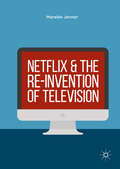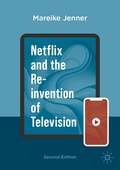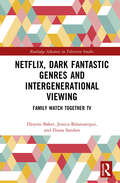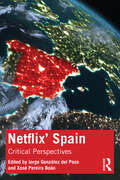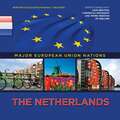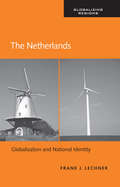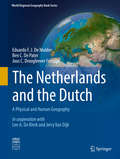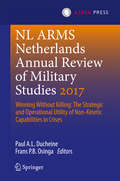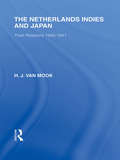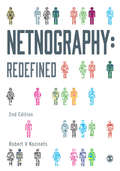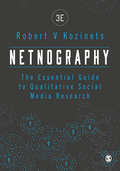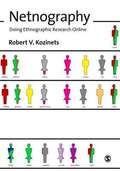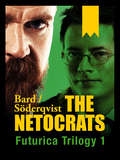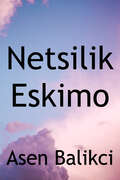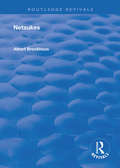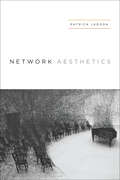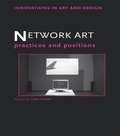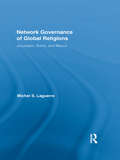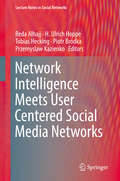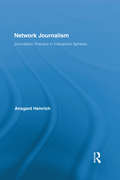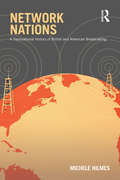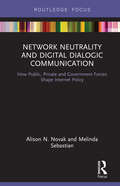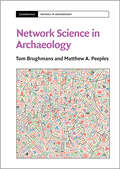- Table View
- List View
Netflix and the Re-invention of Television
by Mareike JennerThis book deals with the various ways Netflix reconceptualises television as part of the process of TV IV. As television continues to undergo a myriad of significant changes, Netflix has proven itself to be the dominant force in this development, simultaneously driving a number of these changes and challenging television’s existing institutional structures. This comprehensive study explores the pre-history of Netflix, the role of binge-watching in its organisation and marketing, and Netflix’s position as a transnational broadcaster. It also examines different concepts of control and the role these play in the history of ancillary technologies, from the remote control to binge-watching as Netflix’s iteration of giving control to the viewers. By focusing on Netflix’s relationship with the linear television schedule, its negotiations of quality and marketing, as well as the way Netflix integrates into national media systems, Netflix and the Re-invention of Television illuminates the importance of Netflix’s role within the processes of TV IV.
Netflix and the Re-invention of Television
by Mareike JennerThis book deals with the ways Netflix influenced the contemporary television landscape and built the infrastructures of streaming. It focusses on various ways Netflix reconceptualises television as part of the process of TV IV. As television continues to undergo a myriad of changes, Netflix has proven itself to be the dominant force in this development, simultaneously driving a number of these changes and challenging television’s existing institutional structures. This comprehensive study explores the pre-history of Netflix, the role of binge-watching in its organisation and marketing, and Netflix’s position as a transnational broadcaster. Netflix and the Re-invention of Television illuminates the importance of Netflix’s role within the processes of TV IV. This Second Edition highlights the role Netflix plays in the so-called streaming wars and incorporates recent research in television studies. It also re-evaluates the companies’ incorporation of issues of diversity in its focus on middlebrow television. The book also includes a new chapter on the transnational streaming franchise, networks of texts developed internal to platforms to build infrastructures of transnational streaming.
Netflix, Dark Fantastic Genres and Intergenerational Viewing: Family Watch Together TV (Routledge Advances in Television Studies)
by Djoymi Baker Jessica Balanzategui Diana SandarsFocusing on Netflix’s child and family-orientated platform exclusive content, this book offers the first exploration of a controversial genre cycle of dark science fiction, horror, and fantasy television under Netflix’s "Family Watch Together TV" tag. Using a ground-breaking mix of methods including audience research, interface, and textual analysis, the book demonstrates how Netflix is producing dark family telefantasy content that is both reshaping child and family-friendly TV genres and challenging earlier broadcast TV models around child-appropriate family viewing. It illuminates how Netflix encourages family audiences to "watch together" through intergenerational dynamics that work on and offscreen. The chapters in this book explore how this "Netflixication" of family television developed across landmark examples including Stranger Things, A Series of Unfortunate Events, The Dark Crystal: Age of Resistance, and even Squid Game. The book outlines how Netflix is consolidating a new dark family terrain in the streaming sector, which is unsettling older concepts of family viewing, leading to considerable audience and critical confusion around target audiences and viewer expectations. This book will be of particular interest to upper-level undergraduates, graduates, and scholars in the fields of television studies, screen genre studies, childhood studies, and cultural studies.
Netflix' Spain: Critical Perspectives
by Jorge González del Pozo Xosé Pereira BoánThis edited collection analyzes the tensions, contradictions, contributions, and new horizons generated and/or imposed by Netflix within Spain’s audiovisual culture. This book provides invaluable insight into how Netflix—first in its role as distributor and then as content creator—has changed the audiovisual landscape in Spain. It discusses how Netflix challenges the traditional method of categorizing film and television output by nationality while also examining how Spain is presented to other countries through the Netflix catalog and questioning what its chosen output—light comedies, mystery/thrillers, narco-fiction, and crime—means for Spain’s national brand. With chapters addressing themes such as reproducibility, pan-Europeanism after Brexit, gender representation, identity, and globalization, this book explores how—under the influence of Netflix—Spain is transitioning from an importer of audiovisual content to a center of export. This book will appeal to students and scholars of Film and Media Studies, Hispanic and Iberian Studies, and Spanish with a specific interest in Spanish film, television, media, and culture, as well as global media industries.
The Netherlands (Major European Union Nations)
by Heather DocalavichThe Netherlands is one of the most progressive countries in the EU. It was a founding member in 1952 and has supported a more unified Europe for a long time. The Netherlands has figured out innovative ways to battle climate change and deal with the global recession. Discover more about this exciting, modern nation!
The Netherlands: Globalization and National Identity (Global Realities)
by Frank J. LechnerThe Netherlands is the first concise, authored introduction available on the topic. The Netherlands has been a key entrepot in the world capitalist system for centuries, but because of relatively recent demographic changes, it has become symbolic of the clash of European and Islamic cultures. Perhaps the most secular nation in the world, it now houses a very large Islamic population. That population is the fruit of globalization, and how the Dutch have responded to this broad cultural shift tells us a great deal about the changing nature of national identity in the age of globalization. In particular, Frank Lechner explains how globalization calls forth very particularistic and localist responses. Along with providing a broad overview of the contemporary Netherlands, Lechner will focus on how globalization is generating new discourses, cultures, and state policies. Among other topics, the book will feature chapters on soccer culture, religion (and the lack thereof), the media, the welfare state, multiculturalism, and the Netherlands place in the larger European Union.
The Netherlands and the Dutch: A Physical and Human Geography (World Regional Geography Book Series)
by Eduardo F. De Mulder Ben C. De Pater Joos C. Droogleever Fortuijn Len A. De Klerk Jerry Van DijkThis book presents a geographical survey of the Netherlands, reviewing recent and historic developments that made the nation. It is a relatively wealthy country and the Dutch belong to the happiest and healthiest on earth. But these qualities are not evenly spread over the country. The urban agglomeration of Randstad Holland in the west hosts most of the nation’s capital and young, well-educated people whereas older and less-educated people are concentrated in the peripheral areas in the north, east and south. Interactions between physical and human geographical aspects of the Netherlands are described quite extensively. Its position on one of Europe’s most prominent deltas, its abundance of energy resources and the course of history have all contributed to its present national position and international networks. But early and recent Dutch have also shaped this country. They reclaimed lakes and shallow seas, protected the lowlands against floods, re-allotted land parcels and designed and developed urban areas. Besides its focus on water-related topics, the book also covers social and cultural aspects. The book also discusses future challenges and offers scenarios for solutions. This is a book for those interested in a wide variety of recent aspects of the geography of the Netherlands described in a historical context. It appeals to students and researchers of many disciplines in geography, urban and landscape planning, water management, history and cultural studies.
Netherlands Annual Review of Military Studies 2017
by Paul A.L. Ducheine Frans P.B. OsingaInternational conflict resolution increasingly involves the use of non-military power and non-kinetic capabilities alongside military capabilities in the face of hybrid threats. In this book, counter-measures to those threats are addressed by academics with both practical and theoretical experience and knowledge, providing strategic and operational insights into non-kinetic conflict resolution and on the use of power to influence, affect, deter or coerce states and non-state actors. This volume in the NL ARMS series deals with the non-kinetic capabilities to address international crises and conflicts and as always views matters from a global perspective. Included are chapters on the promise, practice and challenges of non-kinetic instruments of power, the instrumentality of soft power, information as a power instrument and manoeuvring in the information environment, Russia's use of deception and misinformation in conflict, applying counter-marketing techniques to fight ISIL, using statistics to profile terrorists, and employing tools such as Actor and Audience Analysis. Such diverse subjects as lawfare, the Law of Armed Conflict rules for non-kinetic cyber attacks, navigation warfare, GPS-spoofing, maritime interception operations, and finally, as a prerequisite, innovative ways for intelligence collection in UN Peacekeeping in Mali come up for discussion. The book will provide both professionals such as (foreign) policy makers and those active in the military services, academics at a master level and those with an interest in military law and the law of armed conflict with useful and up-to-date insights into the wide range of subjects that are contained within it. Paul A.L. Ducheine and Frans P.B. Osinga are General Officers and full professors at the Faculty of Military Sciences of the Netherlands Defence Academy in Breda, The Netherlands.
The Netherlands, Indies and Japan: Their Relations 1940-1941 (Routledge Library Editions: Japan)
by H J van MookThis volume chronicles the facts concerning the relations between the Netherlands in Asia and Japan during the last two years before the outbreak of war in the Pacific and concentrates on political and economic affairs.
Netnography: Redefined
by Dr Robert KozinetsSocial media and Internet data offer rich opportunities and vexing challenges for sociocultural research. Explaining and extending prior approaches, Netnography: Redefined is an indispensable guide to the understanding and conduct of Internet ethnography. With this volume, netnography is upgraded, updated and renewed with the latest netnographic research from media anthropology, geography, education, library sciences, travel and tourism, linguistics, media and cultural studies, sociology, sexuality, addiction research, gaming studies, and nursing, and multiple examples from the worlds of Facebook, Twitter, LinkedIn, and other social media sites. Like its predecessor, Netnography: Redefined includes full, step-by-step procedural guidelines for the accurate and ethical conduct of netnography. Yet this edition adapts netnography to include big data and social media analytics, as well as further incorporating notions of network analysis. It deepens the practice of netnography through participative engagement, introspection, alternative representation, and a new humanist focus. Netnography: Redefined presents readers with up-to-date guidelines for the most fully realized and distinctive form of online ethnographic research yet developed.
Netnography: Redefined
by Dr Robert KozinetsSocial media and Internet data offer rich opportunities and vexing challenges for sociocultural research. Explaining and extending prior approaches, Netnography: Redefined is an indispensable guide to the understanding and conduct of Internet ethnography. With this volume, netnography is upgraded, updated and renewed with the latest netnographic research from media anthropology, geography, education, library sciences, travel and tourism, linguistics, media and cultural studies, sociology, sexuality, addiction research, gaming studies, and nursing, and multiple examples from the worlds of Facebook, Twitter, LinkedIn, and other social media sites. Like its predecessor, Netnography: Redefined includes full, step-by-step procedural guidelines for the accurate and ethical conduct of netnography. Yet this edition adapts netnography to include big data and social media analytics, as well as further incorporating notions of network analysis. It deepens the practice of netnography through participative engagement, introspection, alternative representation, and a new humanist focus. Netnography: Redefined presents readers with up-to-date guidelines for the most fully realized and distinctive form of online ethnographic research yet developed.
Netnography: The Essential Guide to Qualitative Social Media Research
by Dr. Robert KozinetsNetnography is an adaptation of ethnography for the online world, pioneered by Robert Kozinets, and is concerned with the study of online cultures and communities as distinct social phenomena, rather than isolated content. In this landmark third edition, Netnography: The Essential Guide provides the theoretical and methodological groundwork as well as the practical applications, helping students both understand and do netnographic research projects of their own. Packed with enhanced learning features throughout, linking concepts to structured activities in a step by step way, the book is also now accompanied by a striking new visual design and further case studies, offering the essential student resource to conducting online ethnographic research. Real world examples provided demonstrate netnography in practice across the social sciences, in media and cultural studies, anthropology, education, nursing, travel and tourism, and others.
Netnography: The Essential Guide to Qualitative Social Media Research
by Dr. Robert KozinetsNetnography is an adaptation of ethnography for the online world, pioneered by Robert Kozinets, and is concerned with the study of online cultures and communities as distinct social phenomena, rather than isolated content. In this landmark third edition, Netnography: The Essential Guide provides the theoretical and methodological groundwork as well as the practical applications, helping students both understand and do netnographic research projects of their own. Packed with enhanced learning features throughout, linking concepts to structured activities in a step by step way, the book is also now accompanied by a striking new visual design and further case studies, offering the essential student resource to conducting online ethnographic research. Real world examples provided demonstrate netnography in practice across the social sciences, in media and cultural studies, anthropology, education, nursing, travel and tourism, and others.
Netnography
by Robert V. KozinetsWith as many as 1 billion people now using online communities such as newsgroups, blogs, forums, social networking sites, podcasting, videocasting, photosharing communities, and virtual worlds, the internet is now an important site for research. This exciting new text is the first to explore the discipline of 'Netnography' - the conduct of ethnography over the internet - a method specifically designed to study cultures and communities online. For the first time, full procedural guidelines for the accurate and ethical conduct of ethnographic research online are set out, with detailed, step-by-step guidance to thoroughly introduce, explain, and illustrate the method to students and researchers. The author also surveys the latest research on online cultures and communities, focusing on the methods used to study them, with examples focusing on the new elements and contingencies of the blogosphere (blogging), microblogging, videocasting, podcasting, social networking sites, virtual worlds and more. This book will be essential reading for researchers and students in social sciences such as anthropology, sociology, marketing and consumer research, organization and management studies and cultural and media studies.
The Netocracts
by Alexander Bard Jan SöderqvistHistory is always written from the perspective of the ruling or rising elite at the time of writing. Concepts like The Stone Age, The Bronze Age, etc. were of course unknown during the stone age and the bronze age. They were invented in the 1800s to make sense of a development that seemed to reach its climax with industrialisation...
The Netsilik Eskimo
by Asen BalikciThis book preserves the traditional way of life of the Netsilik Eskimo "People of the Seal" who lived close to the Arctic Circle in one of the harshest and most demanding environments known to man.
Netsukes (Routledge Revivals)
by Albert BrockhousFirst published in 1924, no book had ever before emerged dealing with Netsukes, one of the most fascinating and interesting forms of expression of the Japanese in art. Netsukes are the exquisitely carved and infinitely varied little knobs used by the Japanese to keep from slipping all kinds of articles which are hung from girdles. For collectors who cannot afford originals in most of the arts, Netsukes offer an alluring field. Here is a branch in which originals are accessible. The Netsuke is a work of art that can only exist once in this world. It is found in Japan only and like the leaves of the trees, there are never two pieces of it alike. This book describes, in a fascinating way, whether you are a collector or the subject is new to you, the use and various kinds of Netsukes, the method of their carving, their subjects, the many extant collections, their history and their mythology.
Network Aesthetics
by Patrick JagodaThe term “network” is now applied to everything from the Internet to terrorist-cell systems. But the word’s ubiquity has also made it a cliché, a concept at once recognizable yet hard to explain. Network Aesthetics, in exploring how popular culture mediates our experience with interconnected life, reveals the network’s role as a way for people to construct and manage their world—and their view of themselves. Each chapter considers how popular media and artistic forms make sense of decentralized network metaphors and infrastructures. Patrick Jagoda first examines narratives from the 1990s and 2000s, including the novel Underworld, the film Syriana, and the television series The Wire, all of which play with network forms to promote reflection on domestic crisis and imperial decline in contemporary America. Jagoda then looks at digital media that are interactive, nonlinear, and dependent on connected audiences to show how recent approaches, such as those in the videogame Journey, open up space for participatory and improvisational thought. Contributing to fields as diverse as literary criticism, digital studies, media theory, and American studies, Network Aesthetics brilliantly demonstrates that, in today’s world, networks are something that can not only be known, but also felt, inhabited, and, crucially, transformed.
Network Art: Practices and Positions (Innovations in Art and Design)
by Tom CorbyNetwork Art brings an international group of leading theorists and artists together to investigate how the internet, in the form of websites, mailing lists, installations and performance, has been used by artists to develop artwork. Covering a period from the mid 1990s to the present day, this fascinating text includes key texts by historians and theorists such as Charlie Gere, Josephine Bosma, Tilman Buarmgartel and Sarah Cook, alongside descriptions of important projects by Thomson and Craighead, Lisa Jevbratt and 0100101110101101.org amongst many others. Fully illustrated throughout, and including many pictures of artworks never before seen in print, Network Art represents one of the first substantial attempts to place major artist's writings on network art alongside those of critics, curators and historians. In doing so it takes a unique approach, offering the first comprehensive attempt to understand network art practice, rooted in concrete descriptions of the systems and the process required to create it.
Network Governance of Global Religions: Jerusalem, Rome, and Mecca (Routledge Research in Information Technology and Society)
by Michel S. LaguerreThis study seeks to explain three models of network governance embedded in digital practices that the mainstream monotheistic religions—Judaism, Catholic Christianity, and Islam—have used to lead and manage the worldwide distribution of their local nodes, exploring the connection between network governance and its digital embeddedness and showing how the latter enhances the performance of the former.
Network Intelligence Meets User Centered Social Media Networks (Lecture Notes in Social Networks)
by Reda Alhajj H. Ulrich Hoppe Tobias Hecking Piotr Bródka Przemyslaw KazienkoThis edited volume presents advances in modeling and computational analysis techniques related to networks and online communities. It contains the best papers of notable scientists from the 4th European Network Intelligence Conference (ENIC 2017) that have been peer reviewed and expanded into the present format. The aim of this text is to share knowledge and experience as well as to present recent advances in the field. The book is a nice mix of basic research topics such as data-based centrality measures along with intriguing applied topics, for example, interaction decay patterns in online social communities. This book will appeal to students, professors, and researchers working in the fields of data science, computational social science, and social network analysis.
Network Journalism: Journalistic Practice in Interactive Spheres (Routledge Research in Journalism)
by Ansgard HeinrichDrawing on current theoretical debates in journalism studies, and grounded in empirical research, Heinrich here analyzes the interplay between journalistic practice and processes of globalization and digitalization. She argues that a new kind of journalism is emerging, characterized by an increasingly global flow of news as well as a growing number of news deliverers. Within this transformed news sphere the roles of journalistic outlets change. They become nodes, arranged in a dense net of information gatherers, producers, and disseminators. The interactive connections among these news providers constitute what Heinrich calls the sphere of "network journalism."
Network Nations: A Transnational History of British and American Broadcasting
by Michele HilmesIn Network Nations, Michele Hilmes reveals and re-conceptualizes the roots of media globalization through a historical look at the productive transnational cultural relationship between British and American broadcasting. Though frequently painted as opposites--the British public service tradition contrasting with the American commercial system--in fact they represent two sides of the same coin. Neither could have developed without the constant presence of the other, in terms not only of industry and policy but of aesthetics, culture, and creativity, despite a long history of oppositional rhetoric. Based on primary research in British and American archives, Network Nations argues for a new transnational approach to media history, looking across the traditional national boundaries within which media is studied to encourage an awareness that media globalization has a long and fruitful history. Placing media history in the framework of theories of nationalism and national identity, Hilmes examines critical episodes of transnational interaction between the US and Britain, from radio’s amateurs to the relationship between early network heads; from the development of radio features and drama to television spy shows and miniseries; as each other’s largest suppliers of programming and as competitors on the world stage; and as a network of creative, business, and personal relationships that has rarely been examined, but that shapes television around the world. As the global circuits of television grow and as global regions, particularly Europe, attempt to define a common culture, the historical role played by the British/US media dialogue takes on new significance.
Network Neutrality and Digital Dialogic Communication: How Public, Private and Government Forces Shape Internet Policy (Routledge Studies in Media Law and Policy)
by Alison N. Novak Melinda SebastianIn the months after the Federal Communications Commission’s (FCC) 2017 decision to repeal network neutrality as US policy, it is easy to forget the decades of public, organizational, media and governmental struggle to control digital policy and open access to the internet. Using dialogic communication tactics, the public, governmental actors and organizations impacted the ruling through YouTube comments, the FCC online system and social network communities. Network neutrality, which requires that all digital sites can be accessed with equal speed and ability, is an important example of how dialogic communication facilitates public engagement in policy debates. However, the practice and ability of the public, organizations and media to engage in dialogic communication are also greatly impacted by the FCC’s decision. This book reflects on decades of global engagement in the network neutrality debate and the evolution of dialogic communication techniques used to shape one of the most relevant and critical digital policies in history.
Network Science in Archaeology (Cambridge Manuals in Archaeology)
by Tom Brughmans Matthew A. PeeplesThe Cambridge Manual to Archaeological Network Science provides the first comprehensive guide to a field of research that has firmly established itself within archaeological practice in recent years. Network science methods are commonly used to explore big archaeological datasets and are essential for the formal study of past relational phenomena: social networks, transport systems, communication, and exchange. The volume offers a step-by-step description of network science methods and explores its theoretical foundations and applications in archaeological research, which are elaborately illustrated with archaeological examples. It also covers a vast range of network science techniques that can enhance archaeological research, including network data collection and management, exploratory network analysis, sampling issues and sensitivity analysis, spatial networks, and network visualisation. An essential reference handbook for both beginning and experienced archaeological network researchers, the volume includes boxes with definitions, boxed examples, exercises, and online supplementary learning and teaching materials.
